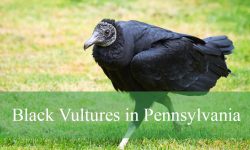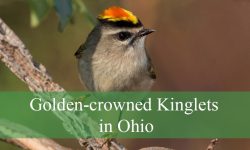When people think of mockingbirds, the Northern Mockingbird usually comes to mind. In Ohio, this is the only true mockingbird species that occurs naturally. Known scientifically as Mimus polyglottos, the Northern Mockingbird is famous for its unmatched vocal ability, capable of imitating the songs of dozens of bird species as well as man-made sounds. Its presence in Ohio has become more common over the past century, especially in suburban and open rural areas.
However, the story does not end there. While the Northern Mockingbird is the only authentic mockingbird, Ohio is also home to two of its closest relatives: the Gray Catbird and the Brown Thrasher. These birds belong to the same family, Mimidae, and share the remarkable talent for mimicry. Many bird enthusiasts group them together because they each contribute to the fascinating chorus of Ohio’s birdlife. Understanding all three species provides a complete picture of how mimicry plays a role in the state’s natural soundscape.
This article explores the Northern Mockingbird in detail, while also highlighting the Gray Catbird and Brown Thrasher as relatives with equally impressive vocal performances. By the end, you will understand how these three species live, behave, and enrich the environment across Ohio.
The Northern Mockingbird in Ohio
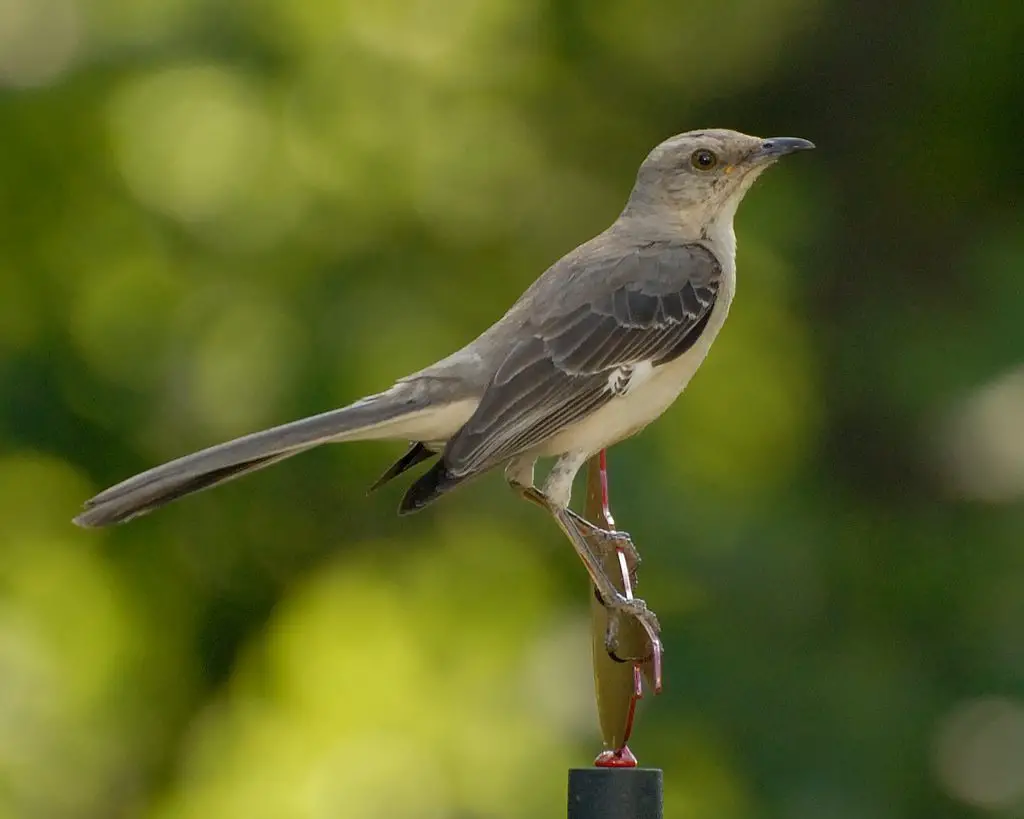
Identification and Physical Characteristics
The Northern Mockingbird is a medium-sized songbird, about 9 to 11 inches in length, with a slender body and long tail. Its overall plumage is gray above and whitish below, giving it a sleek appearance. Distinctive white patches on the wings become especially visible when the bird is in flight or flashing its wings, a behavior it often performs when foraging on the ground.
The bill is slightly curved, dark, and strong enough to handle a wide range of food sources. Its long legs allow it to spend significant time on the ground, and its alert posture adds to its confident look. When perched, the Northern Mockingbird often scans its surroundings with sharp awareness, ready to defend its territory.
Males and females look alike, making them difficult to tell apart by plumage alone. Juveniles appear similar but may have faint streaking on the chest. Despite their subtle colors, their vocal abilities are what make them stand out.
Song and Mimicry
The Northern Mockingbird’s song is legendary. Each male has the ability to mimic dozens of other bird species, as well as frogs, insects, and even mechanical sounds such as car alarms or squeaky gates. Their singing sessions can last for hours, often performed from high perches like treetops, rooftops, or utility poles.
One of the most fascinating aspects is their tendency to repeat phrases. A mockingbird may repeat a single phrase two to six times before switching to the next, creating a rolling medley of sounds. During spring and early summer, their vocal performances become particularly intense, serving both to attract mates and to defend territories.
In urban and suburban Ohio, their songs add a dynamic soundtrack to neighborhoods, making them a favorite among both casual observers and serious birders.
Habitat and Distribution in Ohio
Northern Mockingbirds thrive in open habitats with scattered shrubs and trees. In Ohio, they are most commonly found in suburban neighborhoods, farmlands, orchards, and parks. Unlike some woodland species, they prefer edges and open areas where they can forage on the ground while maintaining access to perches for singing.
Historically, Northern Mockingbirds were not widespread in Ohio. Their population expanded northward during the 20th century, and today they can be seen year-round throughout much of the state. They remain more common in southern and central regions, but their adaptability ensures that they are no longer a rarity even in northern counties.
Behavior and Territoriality
One of the defining behaviors of Northern Mockingbirds is their fierce defense of territory. They are not shy about chasing away intruders, including much larger birds such as hawks or crows. They have even been observed dive-bombing cats, dogs, and people who venture too close to their nesting sites.
During breeding season, males stake out territories and sing from prominent perches. They also perform aerial displays, flying in circles or hovering briefly before returning to their perch. These behaviors emphasize their control over the area and help maintain dominance.
Their territorial nature extends into winter, when they defend food sources such as berry bushes. This persistence makes them one of the most visible songbirds during colder months.
Diet and Feeding Habits
Northern Mockingbirds are omnivorous. In Ohio, their diet changes with the seasons. During spring and summer, they eat insects such as beetles, grasshoppers, and caterpillars. In fall and winter, berries and fruits become more important. They feed on dogwood, holly, mulberry, and other native plants that provide energy when insects are scarce.
Their feeding often takes place on the ground, where they hop and flash their wings while searching for prey. This wing-flashing behavior may startle insects into moving, making them easier to catch. The adaptability of their diet helps them survive in a wide range of habitats across Ohio.
The Gray Catbird in Ohio
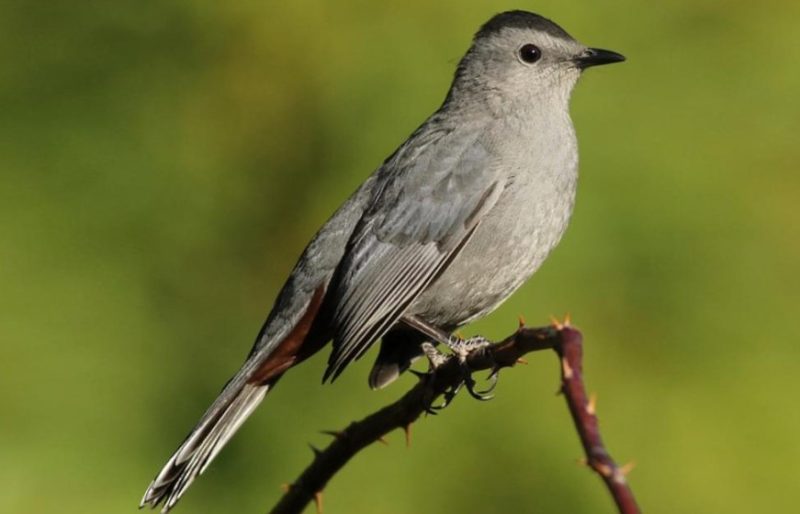
Identification and Physical Features
The Gray Catbird is another member of the Mimidae family and is widespread across Ohio during the breeding season. As its name suggests, it has uniform slate-gray plumage with a slightly darker cap and a small patch of chestnut beneath its tail. It is slimmer than the Northern Mockingbird, measuring about 8 to 9 inches in length.
Despite its plain appearance, the Gray Catbird is distinctive once you hear its voice. It produces a wide variety of sounds, from whistles to harsh notes, often interspersed with its trademark cat-like mew. This unique call is what gives the species its common name.
Song and Vocal Mimicry
Like the Northern Mockingbird, the Gray Catbird is an accomplished mimic. Its song is a long, rambling sequence of phrases that often includes imitations of other birds. Unlike the mockingbird, however, the catbird usually does not repeat phrases multiple times. Instead, it strings together a diverse mix in a continuous, somewhat improvisational performance.
Their songs are especially prominent in dense shrubs and thickets, where they remain hidden while vocalizing. This behavior can make them easier to hear than to see.
Habitat and Distribution in Ohio
Gray Catbirds prefer dense shrubs, thickets, and forest edges. In Ohio, they are common breeders across the state, favoring areas with abundant understory vegetation. They are frequently found in suburban gardens with thick hedges and berry bushes.
Unlike the year-round Northern Mockingbird, Gray Catbirds are migratory. They spend winters in the southeastern United States, Mexico, and the Caribbean, returning to Ohio in spring to breed. Their seasonal presence makes them a welcome sign of warmer weather.
The Brown Thrasher in Ohio
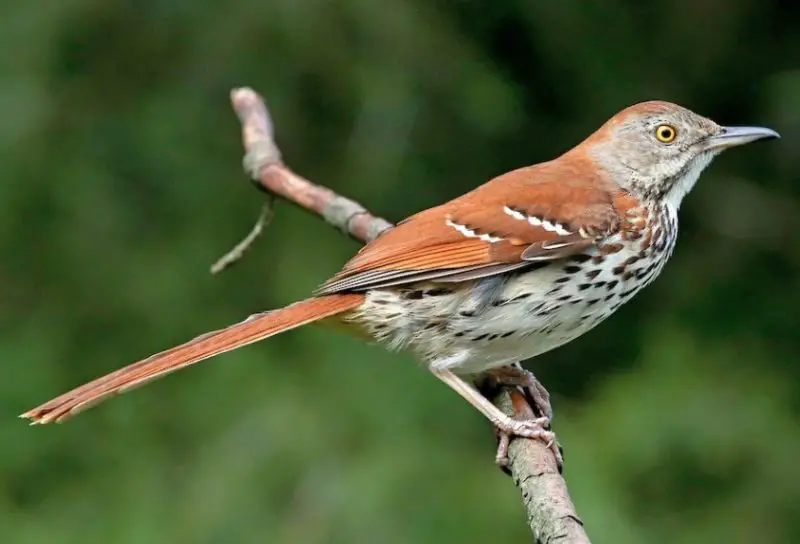
Physical Characteristics and Identification
The Brown Thrasher is the largest of the three Mimidae species in Ohio, measuring about 11 to 12 inches in length. It is recognized by its rich reddish-brown upperparts, heavily streaked white underparts, and long tail. Its bright yellow eyes add to its striking appearance.
This species is less likely to be seen in densely populated suburban areas compared to the mockingbird and catbird. Instead, it prefers rural landscapes with open fields, hedgerows, and shrubby habitats.
Song and Mimicry Abilities
The Brown Thrasher is another master of mimicry, with one of the most extensive repertoires in the bird world. Individuals may have more than 1,000 song variations, making their vocal range truly remarkable. Like the Northern Mockingbird, the Brown Thrasher repeats each phrase twice before moving to the next, a helpful clue for identification by sound.
Their songs are usually delivered from elevated perches in spring and early summer. Despite their impressive vocal skills, Brown Thrashers are often more secretive than mockingbirds, making them harder to observe.
Habitat and Occurrence in Ohio
Brown Thrashers are most commonly found in shrubby fields, hedgerows, and young forests. In Ohio, they breed widely across the state but are less abundant than Gray Catbirds. Their preference for dense, brushy areas makes them somewhat elusive, though their strong songs often reveal their presence.
They are migratory, spending winters in the southeastern United States. In Ohio, they are typically present from April through October.
Mockingbirds and Their Relatives: Ecological Importance
Role in Controlling Insects
All three of these species play an important ecological role by consuming large quantities of insects during the warmer months. Their diets help reduce populations of agricultural pests and garden insects, making them beneficial allies for farmers and homeowners alike.
Seed Dispersal and Plant Relationships
In fall and winter, fruits and berries become vital food sources. By eating these fruits and dispersing seeds through their droppings, mockingbirds, catbirds, and thrashers contribute to the regeneration of native plants. This mutual relationship supports both the birds and the ecosystems they inhabit.
Contributions to Soundscapes
Beyond their practical ecological roles, these birds enrich Ohio’s soundscapes. Their mimicry and vocal diversity create a unique auditory environment that connects people to nature. For many birdwatchers and casual observers, hearing a mockingbird’s song or a catbird’s mew becomes a memorable experience.
Conservation Status and Challenges
Northern Mockingbirds, Gray Catbirds, and Brown Thrashers are all currently considered common species in Ohio. However, they face challenges such as habitat loss, pesticide use, and collisions with windows in suburban environments. Maintaining native shrubs and berry-producing plants in yards and parks can help provide food and shelter for these species.
Climate change also poses potential risks, as shifting temperatures may affect migration patterns and the availability of food sources. Continued monitoring ensures that these charismatic songsters remain a part of Ohio’s wildlife for generations to come.
Best Times and Locations to Observe Mockingbirds in Ohio
When to See Mockingbirds and Their Relatives
Northern Mockingbirds are year-round residents in Ohio, which means they can be observed in every season. They are especially noticeable in spring and summer when males sing for hours from prominent perches to attract mates and defend territories. Their vocal activity peaks in the early morning and late evening, making these times ideal for listening to their wide range of songs. In winter, they are less vocal but remain active, often seen defending berry bushes that provide much-needed food.
Gray Catbirds and Brown Thrashers, on the other hand, are migratory and appear in Ohio mainly from late April through early October. Their presence is tied to the breeding season, during which they sing most actively. Catbirds are easiest to hear in late spring and early summer, while Brown Thrashers are most vocal in May and June. For birders hoping to enjoy the full range of mimicry within the Mimidae family, late spring offers the best opportunity to hear all three species together.
Where to Observe Mockingbirds in Ohio
In terms of location, Northern Mockingbirds are commonly found in suburban neighborhoods, farmlands, orchards, and city parks. They prefer open landscapes with scattered shrubs and trees, making them easy to spot even in residential areas. They are especially abundant in southern and central Ohio, but their range now extends across much of the state.
Gray Catbirds thrive in dense shrubs, hedgerows, and woodland edges, so areas like nature preserves, overgrown fields, and gardens with thick vegetation are excellent places to find them. Brown Thrashers are more secretive but can be observed in brushy fields, young forests, and rural hedgerows. State parks, wildlife refuges, and conservation areas with shrubby habitats provide some of the best opportunities for spotting both catbirds and thrashers.
Together, these habitats create a wide network of observation sites across Ohio. Whether in a quiet backyard with berry bushes or a state park filled with thickets and open fields, bird enthusiasts have numerous chances to enjoy mockingbirds and their relatives throughout the year.
Conclusion
Mockingbirds in Ohio represent more than just a single species. While the Northern Mockingbird is the only true mockingbird in the state, its close relatives—the Gray Catbird and Brown Thrasher—share the same gift of mimicry. Together, these three species create a lively chorus that enhances Ohio’s landscapes throughout the year.
By learning to recognize their songs, habitats, and behaviors, bird enthusiasts can appreciate the diversity of the Mimidae family in Ohio. Whether it is the bold singing of the Northern Mockingbird, the quirky mewing of the Gray Catbird, or the hidden melodies of the Brown Thrasher, each bird contributes to the state’s natural heritage in its own way.
FAQs about Mockingbirds in Ohio
Are Northern Mockingbirds common in Ohio?
Yes, Northern Mockingbirds are now common year-round residents across much of Ohio, though they were once scarce in the northern part of the state.
Do mockingbirds migrate out of Ohio?
Northern Mockingbirds are mostly permanent residents. However, Gray Catbirds and Brown Thrashers migrate south for the winter and return in spring.
How can I tell the difference between a mockingbird and a catbird?
The Northern Mockingbird is larger, with gray plumage and white wing patches, while the Gray Catbird is smaller, slate gray, and has a distinctive cat-like call.
Do mockingbirds in Ohio really mimic other birds?
Yes, the Northern Mockingbird is known for its ability to imitate dozens of bird species and other sounds. Catbirds and thrashers also mimic but in slightly different styles.
What should I plant to attract mockingbirds?
Native berry-producing shrubs such as dogwood, holly, and serviceberry are excellent choices for attracting Northern Mockingbirds and their relatives.





